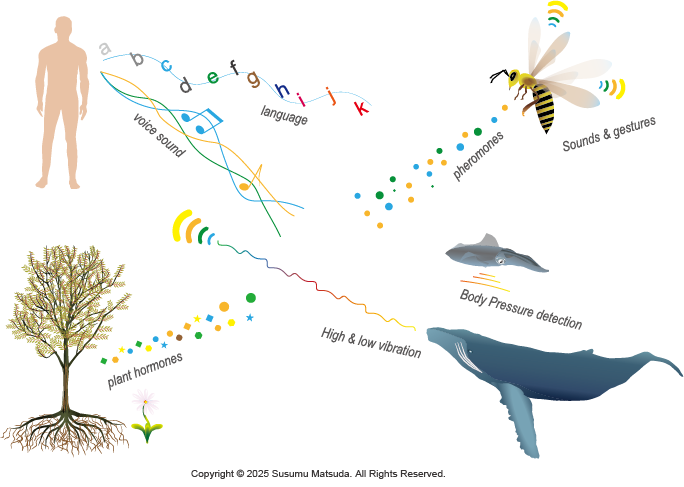Living things use their five senses to grasp and sense their environment and communicate with each other through language and other means of communication. Living things grasp their surroundings with senses optimized for their environment. While human eyes cannot see light in the ultraviolet range, many insects can. Insects such as ants and bees find it more convenient to utilize ultraviolet light than infrared light. The audible range that the human ear can hear is 20Hz to 20KHz. Sounds below 20Hz are called infrasound and sounds above 20KHz are called ultra-high frequency sound. While humans cannot hear low frequency sounds, whales can hear infrasound and use it to communicate with others over long distances. Therefore, whales can hear the sounds of crustal movement within the Earth and can detect earthquakes. Bats and mice communicate using ultrasonic sounds. Honeybees communicate through dance and the secretion of pheromones.

Male cicadas communicate using vocalizations, while females respond with buzzing. Moths and grasshoppers communicate by vibrating their bodies and detecting vibrations with their bodies. When insects eat their leaves, plants produce and secrete plant hormones to alert their neighbors to the damage and release hormones that attract other organisms, seeking their help in eliminating the insects. Prairie dogs can sing, but to avoid capture, they communicate through taste, kissing. Dogs, who live alongside humans, have vision less than one-sixth that of humans, but their sense of smell is 1,000 to 1,000,000 times more powerful. Cats have excellent odor and sound detection abilities. While their vision is inferior to humans in bright light, it excels in darkness, making them useful for hunting. Cats communicate through scent and greet each other by lifting their tails. Adult cats do not communicate with each other by meowing, but they will respond to humans by meowing. Cats appear to be well aware of human characteristics. It has also been scientifically confirmed that vertebrates have language genes in their DNA. In this way, living things perceive their environment with different senses than humans, and communicate in their own ways to survive. We believe that uncovering the means of communication that each living thing possesses, reading the situations that each living thing perceives with its superior sensory organs, and utilizing this information in our activities will lead to peace of mind for both the Earth and people.
Please note: References are provided in the Japanese blog with Amazon links.